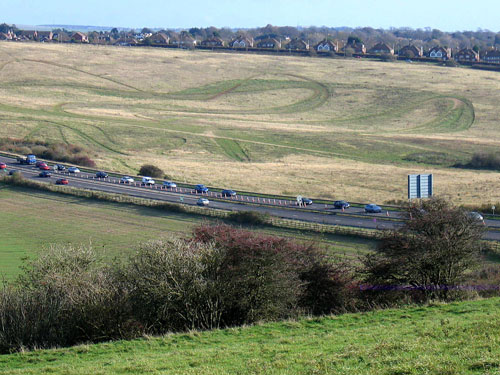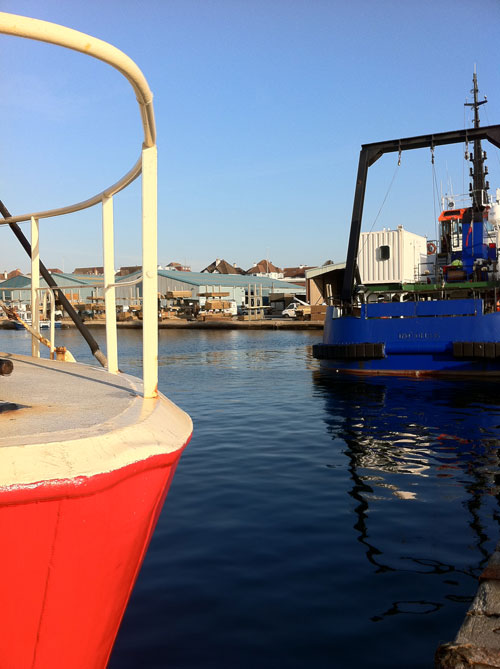Green lung or new homes?
The Greens want to build in Toads Hole Valley but not everyone is happy. Frank le Duc reports

The Greens have shown their true colours – and they’re as grey as concrete. So says veteran Labour councillor Brian Fitch, who is campaigning against plans to build homes, offices and a school in a green lung just inside the Brighton Bypass. He said that they should focus on brownfield sites instead, citing Shoreham Harbour as a case in point. Like Councillor Fitch, two Conservative councillors – Jayne Bennett and Vanessa Brown – have also started a petition to protest against the plans.
They are unhappy about the prospect of 750 homes, with 280 of them likely to be for council or housing association tenants. As well as housing there is the possibility of a much-needed new secondary school, a doctor’s surgery and 30,000 square metres of high-tech offices.
The Conservative councillors’ petition says: “We are extremely concerned about the potential impact of such a large-scale development on the existing residents in the Hove Park and in Hangleton and Knoll areas. The proposed 750 houses will completely overwhelm the existing infrastructure. There will be serious problems with road access and the schools and health facilities will be overwhelmed. We seriously urge the Green administration to think again about this proposal.”
“This is not even a last resort. It’s another U-turn by the Greens”
Councillor Fitch presented his petition to a recent council meeting and said: “Don’t send in the bulldozers to churn up Toads Hole Valley. Hold a proper consultation with the people of Hangleton. I would prefer us to build housing on brownfield sites such as the port of Shoreham before we start digging up the grass and the countryside.” The 116 acres include a Site of Nature Conservation Interest (SNCI). The council has promised to protect and enhance this haven for wildlife which includes slow worms, adders and common reptiles. Badgers also have setts in the area.
Last resort
The debate about Toads Hole Valley has started up again because the council is preparing its City Plan. This is the blueprint for the way we use land and where we can build over the next 18 years. This is not the first time that the site has been put forward for development. It was one of the sites considered when Brighton and Hove Albion were looking for a new home.
It was also earmarked for possible development by the Tories. Councillor Geoffrey Theobald said: “When we as a Conservative administration brought forward this area as being a development of the last resort, we were criticised by the Green Party saying that we were not protecting the countryside. This is not even a last resort. It’s another U-turn by the Greens.
“Seven hundred homes, including family homes, and 25,000 to 30,000 square metres of employment space, a secondary school and playing fields and some open space – how is it all going to fit in? You’re just going to turn this into a metropolitan area and I think it’s quite sad. This will be right on the periphery of the city. People there would be more inclined to have cars than if they were more central.”
And Labour group leader Councillor Gill Mitchell said: “This is going to be a controversial issue. A lot is being packed on the site. There’s no mention of the infrastructure, the road access, etc. And it’s going to be a challenging site to develop given the gradient.” She said that the Greens did not have viable plans to fund the new secondary school that the city desperately needed. She accused them of including a school in plans for the site to make building there more palatable, adding: “If you don’t have a viable plan, you’re going out to consult on a false premise.”
High Standards
Councillor Bill Randall, for the Greens, said: “There are 47 hectares of land there in a city short of land. Even with Toads Hole Valley, 94 per cent of development in the city will be on brownfield land. We know it’s controversial and we will of course consult local people. We’d be looking at an exemplar scheme to be developed as a new One Planet Living community. We wouldn’t get the bulldozers out at Toads Hole Valley because there isn’t much to bulldoze. It’s owned by a family who could, of course, come up with their own scheme but they’ve agreed to work with us.”
He said that there would be more consultation with the people of Hangleton and Knoll and Hove Park when the time came to look at the detail. He said that at the moment, the council was looking at the principle of whether the valley should be used for homes, offices and a school. But even on the principle, the City Plan was out for consultation from Monday (28 May) for eight weeks until Friday 20 July.
The City Plan says: “Toads Hole Valley represents an opportunity to secure new housing, employment, education, open space and community facilities for the city. It is also an opportunity to achieve exceptionally high standards of development, improve accessibility in this part of the city and secure new community facilities, green infrastructure and open space for residents of the new development and for adjacent neighbourhoods.
“As a result, development at Toads Hole Valley should provide an exemplar of sustainable development and demonstrate that the city’s UNESCO Biosphere Reserve objectives can be successfully integrated throughout the development scheme. In terms of design, care will be taken to ensure that future development will not adversely affect views to and from the South Downs National Park.”
At least half the houses are expected to be family homes. The proposed school is expected to have six classes or 180 pupils a year – or up to 900 in total. And whoever develops the site may be expected to reroute King George VI Avenue – or Snakey Hill as it is known locally. Along with plans for 400 homes on the King Alfred site, Toads Hole Valley remains the most contentious site for housing in the council’s sights – for now.

Tony Mernagh
Brighton and Hove Economic Partnership
Of all the political parties that one might imagine would propose building on a green field, the Green Party would probably be bottom of the list. And yet that is precisely what they are proposing to do at Toads Hole Valley. Opponents have jumped all over them pointing out the apparent hypocrisy of pouring concrete over grass. The reality isn’t quite that simple.
The 47 hectare (116 acre) green field in question was once connected to the wider South Downs but was left stranded by the construction of the bypass which rendered it difficult to access and unviable to farm. When the boundaries for the new South Downs National Park were determined, the valley wasn’t included because it was not deemed to be of sufficient landscape quality.
From the air, it is easy to see why. Apart from its western bank it consists mainly of unexceptional scrub deeply scarred by the tracks of joy riders who use it as a motocross course. It contrasts sharply with the lush, green rolling Downs on the other side of the A27.
Of course, bikers using it as an unofficial motocross are breaking the law because it is private land. As the “no trespassing” signs around the perimeter testify, anyone who sets foot on it is guilty, whether scramble bikers or dog walkers or ramblers. Many people think that it belongs to the city but it has actually been privately owned by the Cook family for over seven decades.
It is a shame that, apart from a tiny patch with SNCI (Site of Nature Conservation Interest) designation, access to such a large expanse – the equivalent of 64 football pitches – is denied to the people; even more so because the Brighton and Hove Sports and Recreation Study highlights this as a location that requires more publicly accessible open space. And that isn’t the only type of space that is in short supply. The need for a new primary school in the area is becoming increasingly desperate.
The Green Administration is proposing to include the valley in the City Plan so that part of it could be developed to provide much needed homes and a new school – all with the impressive environmental credentials that the city demands. It could also accommodate some ultra-sustainable employment space linked to the universities just five minutes along the bypass.
Well over a third of the site wouldn’t be built on at all, becoming open parkland properly managed to encourage biodiversity. The development could follow the principles of One Planet Living like BioRegional Quintain’s One Brighton in the New England Quarter.
Some people have already started to lament the loss of a green field but in truth we don’t have one to lose. It belongs to the Cook family who have shown themselves admirably willing to work with planners to address the city’s needs.
If we play our cards right, the city could gain a green space but if we “save” the valley, we may see it disappear. Under the coalition government’s National Planning Policy Framework (NPPF), if Toads Hole Valley isn’t included in our City Plan there will be nothing to stop the owners from submitting a planning application for as many houses as the site can carry. The NPPF proposes a “presumption” in favour of developments if they are deemed sustainable – and there is no legally binding definition.
Fortunately the owners have no desire to do this, preferring instead to work with the local authority to provide a comprehensive mixed use scheme to meet the long term needs of the city. They have owned this site for 70 years. No one could accuse them of having short-term interests.
The politicians who are busy compiling petitions to “save” the site need to ask themselves who they are actually saving it for. The 12,000 people on the council’s housing waiting list or the 6,000 additional people who will be looking for a job by 2014 or the 150 children who will be shoehorned into already overstretched primary schools this year won’t thank them for “saving” something that we can only look at from afar.
It is unfortunate that the valley is in a ward (Hangleton and Knoll) that is split between two political parties, Labour and Conservative, each playing to their respective galleries.
And it was telling that, during the earlier consultation on the four options papers for the City Plan, not one single consultation group voted to “save” the valley. Instead they all saw the sense of developing a part of it with desperately needed homes and workspace so that the rest could be gifted to the city and people could enjoy it without breaking the law. There’s no room for party politics in this debate.




















